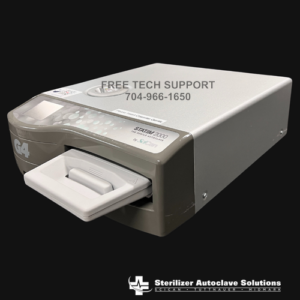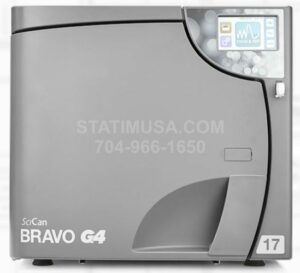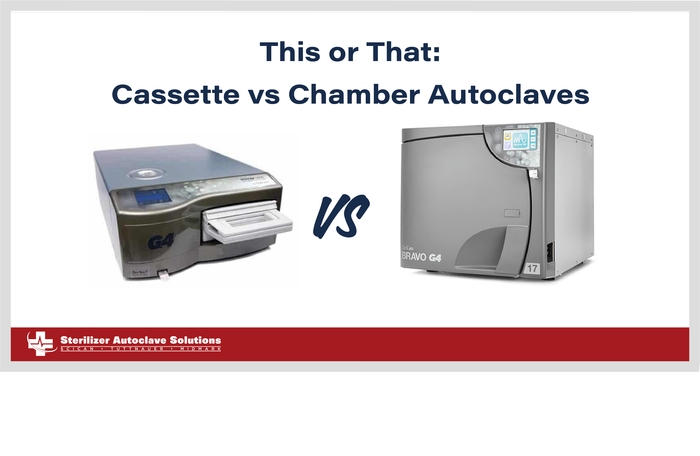This or That: Cassette vs Chamber Autoclaves
Autoclaves come in many different forms. Sometimes the differences between them are minimal, and sometimes there’s a massive difference that can influence your decision making more heavily. In this article, we’d like to cover one of the more major differences that you’ll encounter when looking for the right autoclave. We’ll be looking at the differences between Cassette and Chamber autoclaves.
Here at SAS, we aim to inform people that every single autoclave, new or refurbished, big or small, has its purpose in a practice somewhere…and this topic is no exception. So we’d like to go over what each one is, and give you an example of a unit to help better enlighten you on some things about chambers and cassettes you may or may not have known.
Cassette Autoclaves
Firstly, we’ll go over cassette-based autoclaves. Some of the ones that pioneered various factors in the ever-evolving autoclave landscape. As the name suggests, they operate on cassettes that are inserted into the unit, like the one pictured on the right. These cassettes are pretty much the “chamber” of the unit, as instruments or packages are placed into it for sterilization. Then they’re locked into place until the cycle is complete. And cassette autoclaves have many benefits to them.
For one, since cassette autoclaves are smaller and less intrusive than a larger chamber unit, they can be used in more direct areas in a practice. And the cassette can be removed directly after the cycle ends, making the items inside ready for use immediately. The cassette is beneficial for items that can’t be put into a normal autoclave for any number of reasons. Whether it’s too big or too small, certain materials that can’t withstand normal cycles, etc. The cassette autoclaves are there to be flexible for your practice. They can be used in addition to an already present tabletop autoclave, or on their own. And another added benefit, is if something happens to or within the cassette, in which it’s damaged, the cassette itself can be replaced without having to replace anything inside the machine itself.
All of these benefits and more come with owning a cassette autoclave. While it may seem situational on paper, cassette autoclaves are more versatile than you may realize. A good example of that versatility comes from none other than the Statim G4 2000.
The Statim G4 Cassette Autoclave
A good example of a popular cassette autoclave is the Statim G4 2000. The STATIM G4 will offer you a level of interactivity never seen before. The STATIM G4, through its LCD touch screen control and STATIM Live networking capability, has been designed to provide you with unprecedented ease of use that puts the user in total control. Healthcare practitioners in over 90 countries around the world rely on STATIM to protect their patients and staff from infection – with sterilized instruments complete in just minutes. The STATIM still boasts superior cycle times and processes for both wrapped and unwrapped cycles. In fact, the STATIM Cassette Autoclave® sterilizes up to ten times faster than traditional ‘chamber style’ units. Along with this, the Statim G4 2000 has a wealth of other benefits;
touch screen control and STATIM Live networking capability, has been designed to provide you with unprecedented ease of use that puts the user in total control. Healthcare practitioners in over 90 countries around the world rely on STATIM to protect their patients and staff from infection – with sterilized instruments complete in just minutes. The STATIM still boasts superior cycle times and processes for both wrapped and unwrapped cycles. In fact, the STATIM Cassette Autoclave® sterilizes up to ten times faster than traditional ‘chamber style’ units. Along with this, the Statim G4 2000 has a wealth of other benefits;
- Fast Cycle Times
- Small Footprint
- Data Protection
- Gentle Cycles for Sensitive Materials
- 3.5 inch High-Res Touch Screen
Including the benefits of SciCan’s patented G4 technology, which brings features like:
- Monitoring real-time cycle data
- Instant data logging
- Proactive maintenance management
- Automatic system updates to your G4 machines
You can find the Statim G4 2000 here on our website.
Chamber Autoclaves
“Chamber” autoclaves as a title is just a means of differentiation between the different types of units. But in this section we’re talking about full-size tabletop autoclaves. Those units with a cylindrical chamber that utilizes tray racks and multiple flat trays, as opposed to the cassette style of loading. These are the autoclaves you’ll probably see more often, and there’s definitely a reason for it.
Chamber autoclaves have much larger capacities than a cassette unit, allowing for multiple trays worth of instruments or other sterilization material. Their size also allows them to sterilize much larger packages and bundles, further increasing the capacity. And depending on the specific unit you pick, there won’t be many jobs that they can’t take on with their size and power. That’s not to say they’re the best, of course, this is a fair comparison. But if it’s down to specifics, then maybe the SciCan Bravo G4 will show you what kind of power you can get.
The SciCan Bravo G4 Chamber Autoclave
For an example of a popular chamber autoclave, we can point you towards one of SciCan’s best, the Bravo G4. The Bravo G4 in SciCan’s line of incredible G4 equipped autoclaves. Bringing in quality-of-life improvements that maybe you didn’t think you needed.
- A sleek, modern exterior bringing quality of life improvements to the build.
- The intuitive touchscreen interface using the easy-to-navigate G4 interface.
- Reliability
- The SciCan Bravo G4 units utilize the pre/post vacuum cycle of Class B.
- Fast unwrapped cycle times as fast as 33 minutes.
- The upgrade to G4 technology means this machine takes advantage of many useful features for things like data, profiles, Wi-Fi coverage and more.
- These units feature a new “Delayed Start” feature, able to schedule a cycle whenever you need. Even overnight!
Final Thoughts
While full-size chamber autoclaves and cassette-based autoclaves have the same end goal of providing sterilization, they operate differently and can have different advantages and disadvantages. Full-size chamber autoclaves allow for a wider range of instrument sizes, but require longer cycle times in some instances.
Or on the other hand, cassette-based autoclaves rely on modular cassettes, resulting in quicker cycle times with, but the capacity won’t be the same.
Deciding which type of autoclave to use ultimately depends on the specific needs and preferences of the practice itself. And that can all be determined through proper analysis of how your practice works day-to-day. But once you’re ready to make your choice, SAS is here to help. If you have any questions about this, anything autoclaves or all things infection control, give us a call at 704-966-1650. Or you can find us using or other resources at the links below.
As always if you have any questions about this process or anything else please feel free to contact us and take advantage of our “FREE TECH SUPPORT.”
We also offer FREE VIRTUAL TECH SUPPORT to “See and Talk” with a “Real Time Live Technician” for any problems you may be in need of help with.
You can also use our “FREE MAINTENANCE PROGRAM”. Take the guesswork and worrying about what unit is due for maintenance and which maintenance cycle it is time for. We will keep track of all your autoclaves and let you know when it’s time for anything.


